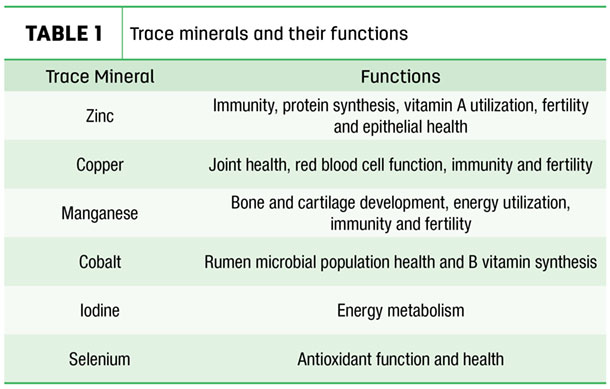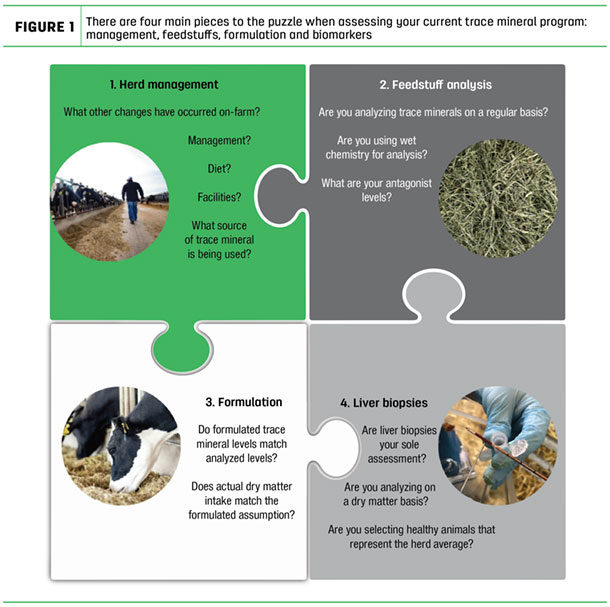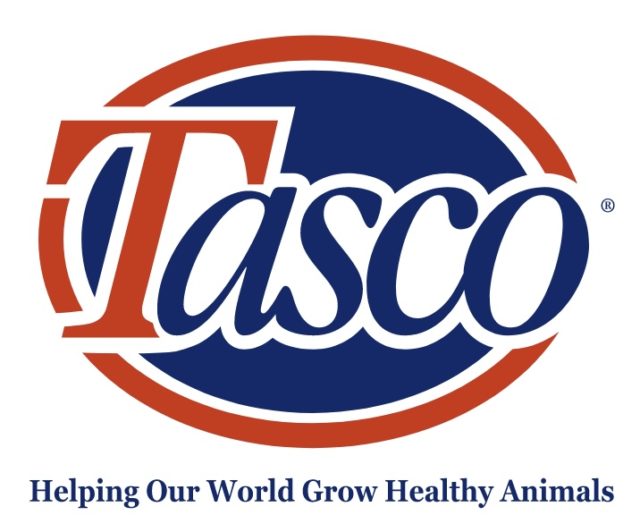Trace minerals are one of the smallest components in a cow’s diet, but they are essential nutrients for animal health and productivity. Because they are such a small part of the diet, trace minerals can often be overlooked until a significant on-farm problem arises. Whether it is a routine audit or a troubleshooting effort, there are four main pieces to the puzzle when assessing your current trace mineral program: management, feedstuffs, formulation and biomarkers (Figure 1).
It is important to think through all four pieces to clearly see the big picture and work to improve your trace mineral program.
1. Herd management
Issues related to trace mineral status are not likely to pop up and disappear erratically, but instead are persistent problems that can build gradually. Trace minerals are a bit like the oil in your car. Too much or too little oil and performance will suffer over time. If a problem prompted the investigation into trace mineral status, it is important to ask: What else is going on in the herd regarding management or feeding that might be important influencers? Is dry matter intake (DMI) being measured, and are there any noteworthy changes? Is it even a diet issue?
2. Feedstuff analysis
The mineral content of the final TMR is the sum of two parts: basal trace minerals that are naturally part of feedstuffs such as silage and grain, and supplemental trace minerals added from a commercial source as part of a mineral pack (think your One-A-Day or Flintstones vitamin, see Table 1). Fluctuations in feedstuff trace mineral content can change the supplemental needs, so it is ideal to make sure basal levels are accounted for when deciding how much supplemental trace mineral to add. Most evidence shows minerals from feedstuffs are fairly available sources for the cow. Furthermore, it is essential to evaluate levels of antagonists such as sulfur, iron and molybdenum in both the diet and the water. These can interfere with trace mineral absorption and, depending on what source you are supplementing, can increase the need for supplemental mineral.
Because trace minerals are present in the diet in such small quantities, there can be lots of variation in the analysis. Dietary levels of trace minerals are commonly measured in milligrams of mineral per kilogram of TMR. To put this into perspective, a kilogram of feed is roughly the weight of a pineapple. Typical supplemental levels would liken copper to two grains of sand per pineapple and zinc to two grains of rice per pineapple. Therefore, it is ideal to ensure accurate analysis using wet chemistry, sample ingredients regularly, observe changes and deviations over time, and resample if a result looks abnormally high or low. It is also a good idea to sample individual forages and feedstuffs and your mineral pack instead of (or in addition to) the TMR. Understanding what is actually going into the animal is a key first step.

3. Formulation
In conjunction with feedstuff analysis, it is wise to check if your analyzed trace mineral levels and intake match with what has been formulated on paper. How does DMI match with what is being formulated? It is OK to use trace mineral book values of basal feedstuffs for formulation purposes, but it’s wise to routinely check these values against an analysis of what is actually being fed. There are many steps in between formulating the mineral on paper and when it gets eaten by the cow. If analyzed values are extremely out of line, they may indicate soil contamination or mixing errors, requiring further investigation.
It is also a good idea to understand what supplemental source of trace mineral is being used. Oxide sources can have poor bioavailability to the animal, while performance with sulfate sources can vary widely depending on antagonist level. Improved trace mineral sources such as hydroxy and organic trace minerals have stronger bonds that avoid antagonists and target mineral release closer to the absorption site. This makes them more predictable and preferred sources.
4. Liver biopsies
Too little trace mineral impairs normal biological processes, while too much can cause harm. Animals are amazing at preserving their trace mineral balance through homeostasis. Cows maintain a very stable and appropriate amount of trace mineral in the blood, even if it means their stores of trace mineral are depleted and they are overall slightly deficient. Unfortunately, this mechanism makes it very difficult to assess trace mineral status of an animal based on blood levels alone, leading to the use of liver biopsy as an assessment tool of trace mineral status. However, liver samples are only useful for assessing copper and selenium because the liver is their primary storage site. Interpretation of other liver mineral levels is less meaningful.
Furthermore, many things can cause variation in liver biopsy results. Samples from sick or dead animals are unreliable because trace mineral distribution changes dramatically during sickness and after death. If you are going to do biopsies, make sure to select healthy cows that represent the herd average. Samples should be analyzed on a dry matter basis because hydration of the sample can vary and change quickly. (You wouldn’t buy or feed your corn silage on a wet matter basis.)
There are other unanswered scientific questions requiring more research efforts and expertise for interpretation: Which region of the liver was sampled? Does stage of lactation matter? Was blood on the sample rinsed off before analysis? While liver biopsies can be a handy tool, their usefulness is limited, and they should be one of the last things done to troubleshoot or assess your trace mineral program. Don’t make them the only piece of the puzzle you evaluate.
Because change can occur slowly with trace mineral status, we need to allow adequate time for dietary changes to influence changes in the results we see. It is futile to repeat trace mineral assessments (especially liver biopsies) less than six months from a trace mineral program change. Be patient, diligent and methodical in your trace mineral assessment. Don’t force the puzzle pieces that don’t fit and use the little details to see the big picture.







